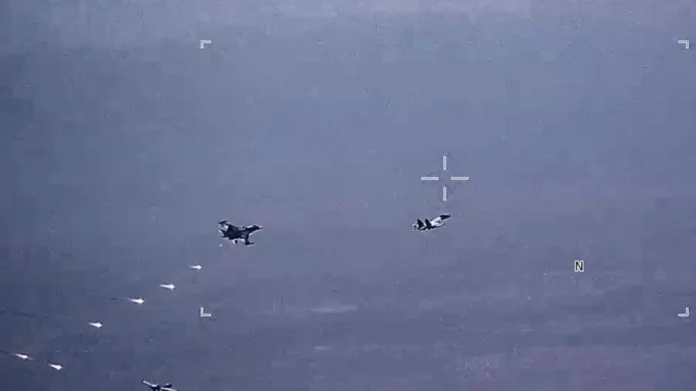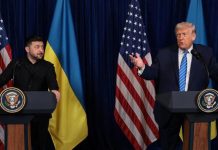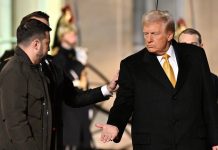WASHINGTON(AP)- The strike in eastern Syria resulting in the death of Osama al-Muhajer, the leader of ISIS in that region, showcases ongoing counterterrorism efforts by the United States and its allies. This operation demonstrates the commitment to combating and defeating ISIS in Syria and beyond. It also underscores the significance of targeted strikes in disrupting the leadership and capabilities of extremist organizations.
General Michael Kurilla’s statement emphasizing that ISIS remains a threat not only to the region but also globally highlights the continued danger posed by the group. Despite significant losses and territorial defeat in Syria in 2019, ISIS has proven its resilience by maintaining hidden pockets, conducting attacks, and maintaining a global network of sympathizers. The need for sustained international efforts to counter and eliminate ISIS remains crucial.
The incidents involving Russian military aircraft harassing US drones participating in operations against ISIS are concerning and demonstrate the complexities and tensions in the Syrian conflict. The aggressive maneuvers, dropping flares, and dangerously close encounters pose risks to the safety of all involved aircraft. The US has called on Russia to cease such behavior, emphasizing the need for de-escalation and adherence to established norms to avoid potential accidents or clashes between the two parties.
Russia’s role as a key ally of the Syrian regime under President Bashar al-Assad is significant in understanding the dynamics of the conflict. With support from Moscow and Iran, the Syrian government has regained substantial territory that was initially lost during the early stages of the conflict. This backing has provided the regime with military support, political leverage, and strategic advantages, contributing to its ability to suppress opposition forces and consolidate control.
The presence of approximately 1,000 US troops in Syria highlights ongoing international efforts to combat ISIS and stabilize the region. Although ISIS suffered significant territorial losses, the group still maintains hidden locations in remote desert areas, allowing them to regroup, carry out sporadic attacks, and pose a persistent threat. The international community, including the US and its allies, continues to play a role in ensuring the lasting defeat of ISIS and supporting stabilization and reconstruction efforts in Syria.
The strike on the ISIS leader, the regional and global threat posed by the group, the harassment of US drones by Russian aircraft, and the ongoing involvement of international forces in Syria all underscore the complex and evolving nature of the conflict. Addressing the ongoing threats of terrorism, de-escalating tensions between parties involved, and pursuing a comprehensive political solution remain critical for the long-term stability and security of the region.
General Michael Kurilla’s statement emphasizing that ISIS remains a threat not only in the region but globally underscores the enduring danger posed by the organization. Despite territorial losses, ISIS has demonstrated its ability to adapt and transform into an insurgent force, capable of carrying out attacks and inspiring or directing terrorism beyond Syria. Countering ISIS’s global network and preventing its resurgence requires sustained international cooperation and intelligence sharing.
The incidents of Russian military aircraft harassing US drones involved in counterterrorism operations raise concerns about potential escalations and the risk of unintended clashes. Such encounters jeopardize the safety of personnel and assets involved and highlight the complexities of operating in the crowded Syrian airspace. Deconfliction mechanisms and clear communication channels between Russia and the US are crucial to avoiding dangerous incidents and maintaining stability in the region.
Russia’s role as a key ally of the Syrian regime, along with Iran’s support, has been instrumental in enabling President Bashar al-Assad to regain control over significant parts of the country. This support has included military assistance, diplomatic backing, and political cover at international forums. Russia’s involvement has shaped the dynamics of the conflict and contributed to the ongoing challenges in reaching a political settlement to the Syrian crisis.
The presence of US troops in Syria, as part of international efforts to combat ISIS, demonstrates the ongoing commitment to ensuring the long-term defeat of the group and stabilization of the region. The complexities of the conflict, the presence of other actors such as Russia and Iran, and the ongoing security challenges necessitate sustained international involvement. Supporting local partners, providing humanitarian aid, and promoting diplomatic efforts are crucial to achieving lasting peace and stability in Syria.
The strike on the ISIS leader showcases the effectiveness of targeted operations, but the global threat of the group persists. The incidents involving Russian harassment of US drones underscore the complexities and risks in the Syrian conflict. Russia’s support for the Syrian regime has been influential, while international involvement remains essential for combating terrorism and fostering stability in the region. Efforts to address the root causes of the conflict and facilitate a political solution are crucial for long-term peace in Syria.






